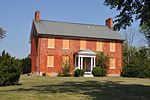John Drinker House
Berkeley County, West Virginia Registered Historic Place stubsFederal architecture in West VirginiaHouses completed in 1815Houses in Berkeley County, West VirginiaHouses on the National Register of Historic Places in West Virginia ... and 4 more
Houses on the Underground RailroadNational Register of Historic Places in Berkeley County, West VirginiaQuakerism in West VirginiaSlave cabins and quarters in the United States

John Drinker House is a historic home located at Bunker Hill, Berkeley County, West Virginia. It was built about 1815 and is a two-story, five-bay, limestone dwelling in the Federal style. It features an arched stone main entrance. The property includes the ruins of a log home that pre-dates the Drinker House, ruins of a stone smokehouse, and the ruins of slave quarters. A dump pile is also located on the property. The house was built by John Drinker (1760–1826), a Quaker portrait artist from Philadelphia. The house is believed to have been a stop on the Underground Railroad.It was listed on the National Register of Historic Places in 1980.
Excerpt from the Wikipedia article John Drinker House (License: CC BY-SA 3.0, Authors, Images).John Drinker House
Sam Mason Road,
Geographical coordinates (GPS) Address Nearby Places Show on map
Geographical coordinates (GPS)
| Latitude | Longitude |
|---|---|
| N 39.318333333333 ° | E -78.08 ° |
Address
Sam Mason Road
Sam Mason Road
25413
West Virginia, United States
Open on Google Maps









